
Can China be contained?
M A Taslim | Wednesday, 24 November 2021
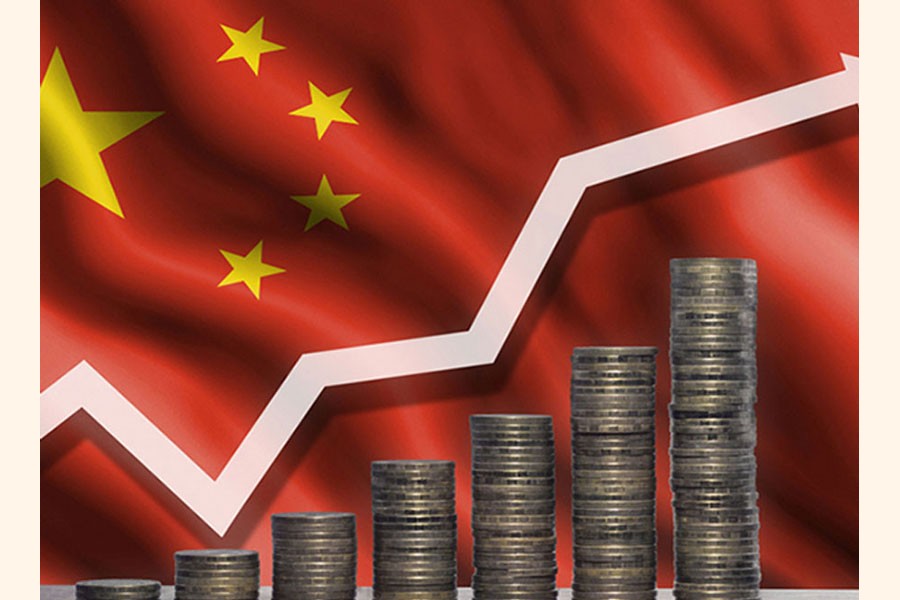
 It is almost embarrassing to admit that China was a poorer (by income per capita criterion) country than Bangladesh as late as the early-1980s. But since then a miraculous near double digit growth rate over long three decades have catapulted China from a dirt poor country to an economic super power, but Bangladesh is still languishing as a least developed country of the world.
It is almost embarrassing to admit that China was a poorer (by income per capita criterion) country than Bangladesh as late as the early-1980s. But since then a miraculous near double digit growth rate over long three decades have catapulted China from a dirt poor country to an economic super power, but Bangladesh is still languishing as a least developed country of the world.
The rise of China, a country of 1.4 billion people, from extreme poverty to a high income country in such a short period is often regarded as the greatest achievement of humanity during the last several decades. Furthermore, never before in human history were so many people, more than 850 million, liberated from the yoke of poverty in such a short time. There were several East Asian countries, such as Japan, South Korea, Taiwan and Singapore, which had become rich quickly, but none had anywhere near the impact that China's rise already has had on the world.
Three years are important in a discussion of the meteoric rise of China: 1949, 1971and 1979. The Chinese Communist Party took control of the mainland China and unified it under its rule in 1949. It made substantial progress in education, health and industrialisation over the next three decades, which set the stage for the next big step. In 1971 the Secretary of State of the United States of America (US), which then did not recognise the communist-ruled country, made a secret trip to China in a bid to improve the existing antagonistic relation. This led to a state visit by US President Nixon in 1972 and a formal diplomatic recognition in 1979. This was instrumental in China's rapid rise as US no longer significantly obstructed China's development through economic sanctions and covert or overt measures. The most important event was, however, internal - the abandonment of the socialist economic structure and the reintroduction of the free market and private property in the economy in 1979 by the then paramount leader Deng Xiao Ping. China opened up its economy for international trade as well as foreign investment. It is no coincidence that China's miraculous growth began soon after these epochal reforms.
These structural changes encouraged corporations from US and other countries to relocate their industries in China to take advantage of the limitless supply of cheap and compliant labour. Much of their production was exported to the mother countries and elsewhere. As China grew rapidly a large domestic consumer market developed which became an additional attraction for relocating industries in the new 'factory of the world'.
Another important economic stimulus came in the form of membership of the World Trade Organisation in 2001. It brought down the trade restrictions, often quite stiff, that China's products faced in importing countries. The easing of these restrictions further raised its competitive edge in the global market. Chinese exports expanded an astounding 5.5 times in just 7 years before the recession of 2008-09. 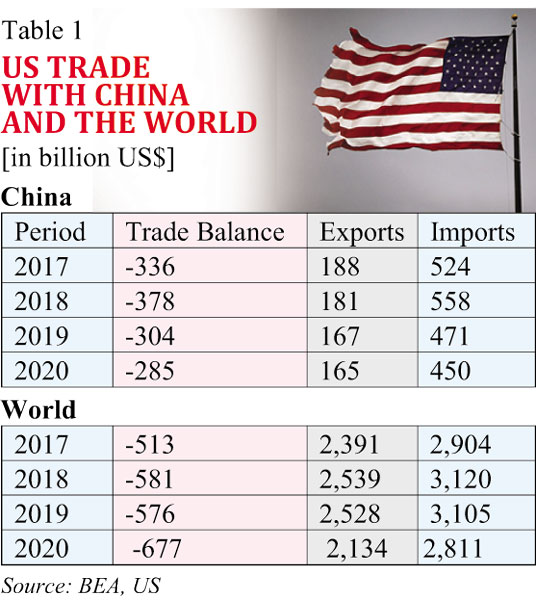 China became a trillion dollar exporter in 2007 and overtook US as the largest exporter of the world in 2013 with exports worth 2.35 trillion dollar.
China became a trillion dollar exporter in 2007 and overtook US as the largest exporter of the world in 2013 with exports worth 2.35 trillion dollar.
All through this time US played a helpful role in China's development. The main reason for normalisation of ties and the subsequent beneficial role was to recruit China to contain the Soviet Union (USSR), then the second super power and the principal enemy of US. China did quietly oblige US in this respect. However, US attitude started changing after USSR imploded into many countries with none offering significant challenge to be credibly called a threat.
China had assiduously followed Deng's wise advice of maintaining a low profile in order not to attract too much attention. But this changed after Xi Jinping became the President. In two important speeches in 2013 he declared a revolutionary economic and strategic plan to build a Silk Road Economic Belt and a 21st Century Maritime Silk Road to connect Asia, Europe and Africa by land and sea. These later came to be known as the Belt and Road Initiative (BRI).
This initiative involved building tens of thousands of miles of roads and rail tracks to connect numerous cities and towns in these continents. Several ports were to be built or renovated along the maritime Silk Road. Many bridges, power stations and other installations were also to be constructed. Thus BRI was essentially an infrastructure project, which every developing country needed and wanted. A fund running into jaw-dropping trillions of dollars was to be made available for this purpose. According to China daily more than 200 cooperation agreements with 172 countries, regions and organizations have been already signed under the BRI framework by 2021. Without doubt this is the largest international cooperation project ever executed by any country or organisation.
There was nothing low profile about President Xi's announcements. These immediately attracted worldwide attention and hogged headlines in the news media ever since. Furthermore, Nobel Memorial Prize winner economist Joseph Stiglitz prematurely stated that China had become the largest economy in 2014 (Vanity Fair January 2015).
The current hegemon of the world, US, must have watched these developments with some trepidation and wondered about how to slow down China. The first substantial government reaction to its rise was made by President Obama when he announced 'a pivot to Asia' and attempted to create a free trade area styled Trans Pacific Partnership with other Pacific Rim countries. However, all the details of this trade agreement could not be finalised before Obama left the White House.
The next President Donald Trump discarded it outright when he took charge. Thus US attempt to disadvantage China's access to a major trading area of the world to contain its rise did not materialise. Curiously China has now applied to join the agreement. In the event it goes through China will have replaced US in the very free trade agreement that US had painstakingly built up to contain it. Moreover, China has already signed a Regional Comprehensive Economic Partnership Agreement with 14 Asia-Pacific countries which will go into effect next year.
The GDP at Purchasing Power Parity estimates of 2017 published by World Bank put China at the top for the first time, which generated a lot of discussion and admiration for China. This must have peeved the super nationalist and racially bigot President Trump that the very institutions engineered by US to protect its hegemony were adulating China.
He savagely attacked China accusing it of pillaging and raping US. He griped that China was not buying much from the US, but US was increasingly buying more from it leading to a large trade deficit, and importantly, shuttering many US industries. To reverse the trend he imposed very high tariffs on imported Chinese products. Predictably China retaliated with similar measures and thus a trade war ensued. As economic theory predicts, such a war reduces trade of both countries. US Exports to China fell sharply as did imports and the trade deficit (see Table 1).
It is possible to fool the uninformed with such figures as a reflection of success of Trump's policies to penalise China. However, the welfare of a country does not depend on its trade outcome with a single country, but with all the countries. The real US complain was its very large trade deficits in goods and services. By targeting China all US could achieve was a reduction of trade and deficit with China only, but not necessarily the global trade deficit.
As apparent from Table 1, US global import suffered much less implying that US substituted import from China with import from other countries, perhaps at higher cost; but export declined considerably. The net result was a substantial increase in the global deficit. There is no quick fix in trade. Furthermore, the US trade deficits are really not a trade problem, but mainly a macroeconomic issue of paucity of US saving. 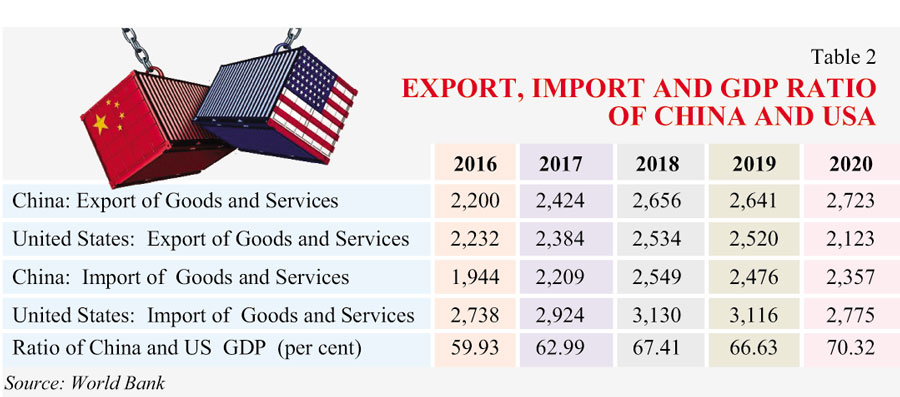 Although the trade war has attracted most attention, the real battle between US and China is being waged in the high tech sector. It was anticipated that the current hegemon would resort to all measures to contain the challenger in order to retain its supremacy in high tech, which is also essential to maintain
Although the trade war has attracted most attention, the real battle between US and China is being waged in the high tech sector. It was anticipated that the current hegemon would resort to all measures to contain the challenger in order to retain its supremacy in high tech, which is also essential to maintain 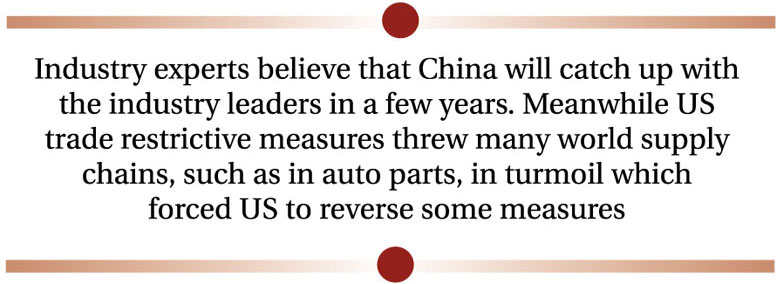 military supremacy. Even when US-China relationship had not deteriorated, the Obama administration intervened to prevent China from joining the US-Russia joint space station program. This led China to start its own very successful space program.
military supremacy. Even when US-China relationship had not deteriorated, the Obama administration intervened to prevent China from joining the US-Russia joint space station program. This led China to start its own very successful space program.
The principal driver of technology in the modern world is the tiny semiconductor or chip. Virtually all electronic gadgets, from refrigerator to space station and artificial intelligence, are driven by chips. There is thus a huge and expanding demand for chips as technology progresses. However, chip manufacturing is a very difficult enterprise, and very few countries have marshalled the art. Hence, chip manufacturing is highly concentrated both geographically as well as industrially. The principal enterprises in the various stages of chip manufacturing are few in number and concentrated mostly in Taiwan, South Korea, Holland, Japan, Singapore, USA and China; but the first two countries dominate the industry, especially the high end section. China uses nearly one-half of the global output of chips, but produces only a fraction of the lower end chips. Last year it spent US$380 billion for importing chips. This dependence made it look like an easy prey to US.
The first major target US chose was China's largest telecom equipment vendor Huawei. It is the pioneer in the development, and the principal supplier, of 5G technology in telecommunication. US alleged it also worked for the Chinese government, and hence was a security threat. Huawei was banned from supplying 5G equipment to, and buying high end chips from US. There was no evidence to substantiate US allegations. Huawei protested but to no avail. US even had Canada arrest the Chief Financial Officer of this giant corporation. The main worry of US was the leadership of China in 5G technology. Trump eventually admitted the real reason for the ban: "We cannot allow any other country to outcompete United States in this powerful industry of the future."
US also prevented its allies from installing Huawei 5G network, and if a country had already started installing (as UK did), it had to uninstall it. US also used licensing and other agreements with allied countries such as Taiwan (TSMC) and South Korea (Samsung) to prevent the sale of semiconductors, especially high end chips, to China. Importantly, US also prevented a Dutch company ASML, the only reliable producer of extreme ultraviolet lithography machines needed for manufacturing the most advanced chips, from selling to Chinese companies. Realising the difficult situation it was being pushed to, China ramped up R & D spending in chip manufacturing massively. Industry experts believe that China will catch up with the industry leaders in a few years. Meanwhile US trade restrictive measures threw many world supply chains, such as in auto parts, in turmoil which forced US to reverse some measures.
US trade and economic sanctions against China did not yield the desired results. The trade restrictions did reduce US-China trade as noted earlier, but China's global export during the Trump presidency increased by 24 per cent while US export declined by 5 per cent (see Table 2). China's global import increased by 21 per cent while US import increased by only 1 per cent. It would seem US was hit harder than China by these trade sanctions. China not only greatly expanded its dominance in world export trade; it also substantially reduced US dominance in world import trade. The end result was that on Trump's watch China overtook US as the largest trading nation of the world in 2020 with total trade in excess of $5 trillion.
Of greater significance is the rapid reduction of the gap in the economic heft of the two countries. When Trump took office China's GDP was less than 60 per cent of US GDP, but by the time Trump was voted out China's GDP exceeded 70 per cent of US GDP. The GDP numbers for the first three quarters of 2021 suggest that this ratio will rise above 75 per cent in 2021. China seems to be on track to become the largest single economy of the world (at current US$) before the end of the decade.
Despite US attempts its allies have built up strong economic relationship with China. Most of the European countries have joined BRI and they are enjoying a spurt in their exports relative to those who did not. China is the largest trading partner of virtually all substantial Asia Pacific countries and all Quad countries as well as EU and Africa. It is no wonder that these countries are reluctant to pick up any trade dispute with China. To ensure that they maintain this position China heavily penalised Australia for its 'misdemeanour'. The visits of US Vice President and Secretaries to East Asia in recent months to mobilise support against China were unsuccessful. Apparently US no longer has a strong enough leverage with many countries to form a coalition against China.
Toward the end of 2019 a large city of China, Wuhan, was struck by an unknown virus which was later named COVID-19. Initially China tried to deal with the virus itself, but soon realised it was a highly contagious and deadly virus with no known antidotes. It promptly took the only preventive step it could in the face of the ominous epidemic - it locked down the entire city of 11 million with brutal efficiency. It also informed WHO of the nature of the great danger it faced by the end of December 2019. (Lancet published five papers on this contagion in January 2020.) Furthermore, China started real time televising of the plight of the patients and the efforts of the health workers to contain the spread of the virus. There were also regular updates of the vital statistics of the contagion.
These efforts should have made the world aware of the oncoming peril and the urgent need for preventive and remedial action. Unfortunately, most of the world did not pay much attention. The Western world, especially US, scorned China's effort as inadequate and contrary to democratic norms such as rights to freedom of movement and association etc. Worse still, US and its allies hinted that the virus might have been engineered by China. Thus, the most deadly public health issue of a century was turned into a political circus which impeded proper health measures to contain the pandemic.
The failure to take the simple precautions such as masking, social distancing and washing hands, had an enormous impact on these countries. In US alone about 48 million people were infected and nearly 800 thousand died and yet there was no non-partisan public outcry. China, which has a population more than 4 times that of US, suffered a death toll of about 5 thousand, almost all in Wuhan. The brutal lockdown did help China to prevent the virus from spreading to other cities and towns. Only four countries with populist governments that resisted preventive measures, namely US, Brazil, India and UK, accounted for nearly one-half of the world infection and two-fifths of the total death.
Covid-19 did serve to highlight the critical role of governance in managing a country in times of a pandemic or any similar emergencies. With the best and the most abundant health services of the world the richest countries suffered the most. Their reputation were also not enhanced when they refused to provide vaccines to less developed countries until they had vaccinated their entire population, or relax the intellectual property rights restrictions to permit them to produce the vaccines themselves at an affordable price. The world also watched in horror what US lethal sanctions did to patients in countries such as Iran which could not access even ordinary medicines from overseas.
Most of the developing world is still without protection against the virus. Although China and Russia are providing vaccines and the West has joined in, the amounts are far short of the need. China became the major supplier of COVID-19 related medical products to the world. China and Russia offered to set up joint vaccine production facilities in some countries including Bangladesh. The pandemic seems to have tarnished the image of US and its allies, but brightened that of China. Incidentally, the recent attempt of US and its allies to embarrass China with human rights issues in the UN General Assembly fell flat when Cuba mobilised 62 countries to defeat its resolution suggesting an erosion of US influence in the UN.
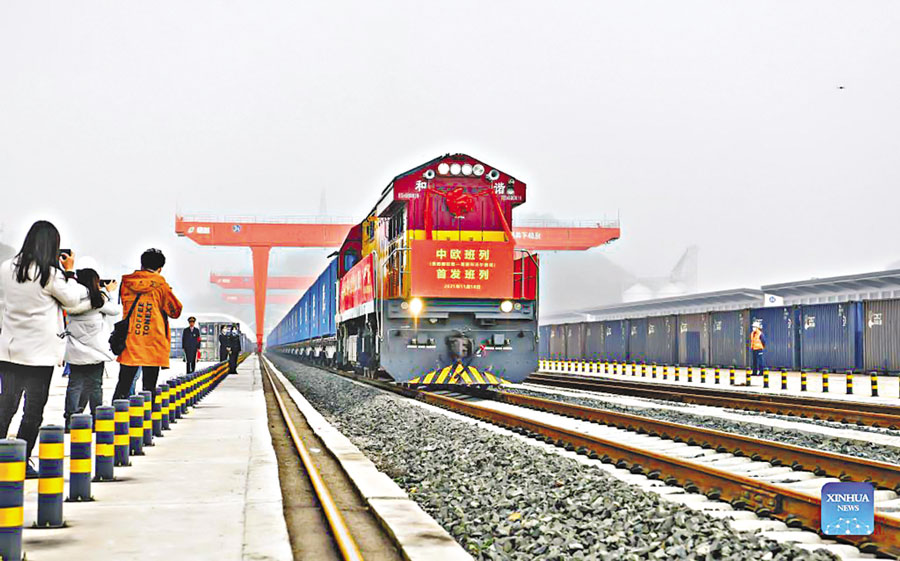
The first direct China-Europe freight train linking southwest China's Guizhou Province and Russia's Moscow sets out from Guiyang in Guizhou on November 18, 2021 — Xinhua Photo
China has been put on a tight spot in respect of its claim on South China Sea and Taiwan. It has apparently reclaimed land around some islets in this Sea and built a military base. The neighbours fear that this might lead it to claim a large chunk of the mineral-rich Sea (similar to nine dash line). No country has so far formally agreed to any Chinese claim, but most of the countries in the region have chosen to keep a low profile and solve the problem with China quietly. But US and its allies, especially UK and Australia, have asserted their maritime navigation right and sent war ships to the area to defend it. They are claiming to protect unhindered access to their trade routes through the Sea, which carries about one-third of the world merchandise trade. The irony of the claim is that the lion's share of the trade of all these countries though this Sea is with China. This was hilariously exposed in an Australian video caricature which concluded that the real challenge was to "protect our trade with China from China".
Since a major part of trade through South China Sea is actually with China, the biggest loser in case of any flare up that hinders safe maritime passage will be China. Hence, it is more likely to protect passage than hinder it. Nonetheless, it will be projected as a hotspot in US-China relation that has the potential to blow up into a destructive conflagration. Although Taiwan is also a hot button issue, many experts discount the prospect of US initiating a risky war against China for a small country that it renounced more than four decades ago.
China has been characterised as a civilisational state (vide Professors M. Jacques and K. Mahbubani). Chinese history suggests that it seldom engaged in wars to expand its empire; rather it built the wondrous Great Wall to prevent attack from outside. There is no definitive evidence that it is planning an invasion. It has successfully negotiated secure borders on all sides except the south. China's concern is most likely a naval aggression from the South China Sea, and hence it might regard the building of military installations in this Sea as the modern maritime counterpart of the ancient Great Wall built on land for the same purpose of repelling foreign aggressors rather than using it as a springboard for invading other countries.
An abiding principle of China's foreign policy that is rooted in its millennia -old civilisation is non-interference in the internal affairs of other countries and conversely. Most of the things that China is harangued about, such as autocracy, press freedom and human rights, are mostly internal affairs which do not directly impact much on other countries. On the other hand, most of the things that US and its allies are accused of, such as regime change, aggression and sanctions, directly affect the life, livelihood and properties of the people of other, mostly developing, countries. It is a matter of individual choice what one prefers, but many countries seem to be leaning toward China.
Currently China's greatest challenge is economic development - to 'build a modern socialist country that is prosperous, strong, democratic, culturally advanced and harmonious' by 2049. China has already attained its first goal of becoming a 'moderately prosperous' country by 2020. To succeed in the more ambitious second goal it needs a world in peace with unfettered trade, which was the bedrock of its success since 1979.
On the other hand US, like all other great empires of the West, became rich not only by peaceful means, but also by brutal conquests, mass killing, pillaging, subjugating and enslaving. Even now it is occupying a large swath of Syria and draining its resources. Iran and Afghanistan accuse it of stealing their reserves and inciting revolt. It seems likely that it could connive to drag China into a war. But China will not be easy to dupe into a war. Unless its core interests are threatened it is most unlikely to go to a devastating war against US or its proxies, which will throw it off-course from its development agenda. Threatening its core interests essentially means attacking its territorial sovereignty, in which case an all-out war will be a near certainty. China is savvy enough to realise that war must be taken to the US mainland to have any sobering impact on US. It will be very unwise of these adversaries to take such a risk.
China's stated long term goal of development is what every country of the world (except some former colonial powers) appreciates, supports and wants to emulate. The principal objective of US is to contain China and any other county that challenge its hegemonic power. It uses threats, sanctions and war to attain that goal. However, the first two have not had much impact on China. With every passing year the effectiveness of these will wane rapidly. Hence, US may be tempted to consider resorting to a proxy or actual war. Such an adventure may be avoided if a sufficiently large or powerful section of the US population stiffly opposes it; or if China can convince US of the devastating consequences of a war that could spill over to the US homeland on the one hand and the large benefits of cooperation with it on the other. If China succeeds in convincing US to avoid war, it will have attested to the wisdom of an ancient military general Sun Tzu who had famously said: "The supreme art of war is to subdue the enemy without fighting".
The writer is a former professor of economics, University of Dhaka.
m_a_taslim@yahoo.com